30. Doney Hollow to West Fulton
Section 30: Doney Hollow to West Fulton
Quick Facts
Distance: 8.6 miles
Parks: Burnt-Rossman Hills State Forest (Eminence State Forest)
Maps: Interactive Map
Print-Friendly Version: Link
General Description
In this section, the Long Path passes from Doney Hollow to the highlands of Eminence State Forest. While there are no great views in this section, the trail is full of glimpses of the area’s historic past. Along the way, the trail passes through sites of abandoned sawmills, gristmills and cemeteries, evidence that this area was once settled. In the early to mid-1800s, this area was home to some of the earliest settlements in the Schoharie region. During the depression in the 1930s, the State purchased many of the marginal farms in this area to establish state reforestation areas. The CCC built some primitive roads on this newly acquired state land. This section of the Long Path gradually ascends from Doney Hollow to the highlands of the Burnt Hill Reforestation Area. It then descends to Cole Hollow before again climbing to the level highlands of Rossman Hill. From there, the trail descends steeply to Sawyer Hollow and the Village of West Fulton. For part of the way, the Long Path follows the Schoharie Trail, which was constructed in the early 1980s by the SUNY Cobleskill Outing Club. In areas where the Schoharie Trail follows drivable roads, the Long Path follows newly constructed trail.
Access
Take the New York State Thruway to Exit 21 (Catskill). Continue on NY Route 23 west for 35 miles to Grand Gorge. In Grand Gorge, turn right, and follow NY Route 30 north for about 8 miles to North Blenheim. Turn left on West Kill Road, which is the second left after Route 30 crosses the West Kill, and follow West Kill Road for 2 miles to Doney Hollow.
Parking
0.00 At West Kill Road in Doney Hollow. (42.48519°, -74.48447°)
5.00 On Duck Pond Road by the brook. (42.53787°, -74.48214°)
6.40 DEC trailhead parking lot on Morey Road. (42.54862°, -74.49069°)
7.40 Sawyer Hollow Road where Long Path enters the road. (42.55906°, -74.48641°)
8.90 Village of West Fulton picnic area. (42.56438°, -74.46290°)
Camping
Camping is allowed in the state reforestation areas 150 feet from the trail and water.
5.85 Rossman Hill Lean-to.
Trail Description
0.00 The Long Path turns right off West Kill Road and follows an old road up Doney Hollow. This section of the Long Path, which is marked with Long Path aqua blazes, heads uphill on the left side of the stream and soon starts a large switchback to the left because the old road ahead has been washed out. [The original route followed the Schoharie Trail, constructed in the early 1980s by the Cobleskill Outing Club (COC). Its start is designated by a COC trail marker.]
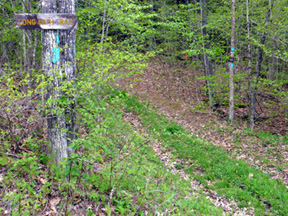
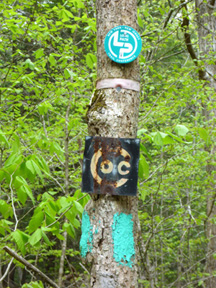
Doney Hollow. 2014 [JAKOB FRANKE]
0.40 The trail reaches the old road along the stream again.
0.55 The trail crosses Doney Hollow on a bridge and continues uphill on the right side of the stream. In about half a mile stone walls appear on the right.
1.05 To the left is a large man-made structure, constructed of local rock. This is the site of one of the two water-powered sawmills that operated along Doney Hollow in the mid 1800s. The rock structure was part of an impoundment of the stream. This section of the trail is on the Burnt Hill Reforestation Area of Eminence State Forest. Burnt Hill got its name from the many wildfires that spread through this area in the early 1900s, improving the huckleberry crop. One part of the area was known as Huckleberry Kingdom. Today, the area has become a mature forest, and the state periodically harvests the timber here. The trail continues on the old road, flanked on the right with stone walls.
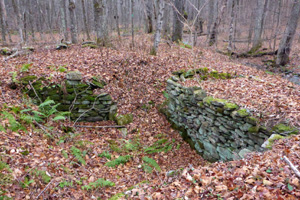
Remnants of saw mill in Doney Hollow. 2015 [JAKOB FRANKE]
1.45 A woods road comes in from the right. On the left is the site of a homestead. The Long Path continues straight ahead. The trail passes through a stand of red pines and begins to level off, passing through an area that is occasionally wet.
1.90 The old woods road ends at the gravel Burnt Hill Road. The Long Path crosses Burnt Hill Road and continues north through the woods.
2.15 An opening to the left leads to a large unnamed pond off Burnt Hill Road. Camping is allowed in the state reforestation areas 150 feet away from the trail or water. The trail continues ahead through the woods to the right of the pond, crossing a short bog bridge and a small bridge.
2.40 The trail reaches the crest of Burnt Hill, turns left, and begins a steep descent to Cole Hollow.
2.50 Turn right and begin to follow a snowmobile trail.
2.60 Turn left onto an old logging road, leaving the snowmobile trail. The logging road soon ends, and as the trail descends it follows a series of switchbacks, eventually turning left and descending on an old woods road to the bottom of Cole Hollow.
3.00 The trail reaches the stream and continues west, close to the stream.
3.30 Turn left on gravel Cole Hollow Road, and continue uphill on the road. To the right the gravel road crosses the stream on a bridge.
3.85 Just after crossing into the Town of Fulton, Cole Hollow Road turns left. The Long Path turns right and follows gravel Huckleberry Kingdom Road.
3.95 On the right is the site of an old homestead, at the corner of an open field.
4.20 The trail goes back into state land and soon crosses a small stream. Just after the stream crossing, the trail turns left off the road, and follows the stream uphill.
4.35 The trail passes a cellar hole on the left, and a number of stone walls on the right. This is said to be the site of the childhood home of Henry Conklin. Author of ‘Through Poverty’s Vale’, he wrote about the difficulty of eking out a living in these hills around 1840. This book, an interesting early history of the Schoharie Valley, is available at the Old Stone Fort in Schoharie. The Long Path parallels the stream while it continues uphill through a hemlock gorge.
4.80 Turn left and cross the stream on a bridge, following a tributary uphill. Near the top of the hill, the trail turns right and leaves the stream. Here, to the left, there is a series of cascading waterfalls along the stream.
5.00 The Long Path turns left onto the first of a series of CCC-constructed roads. Just before Duck Pond Road crosses the stream, there is a small parking area. Near a concrete abutment along the stream, the trail turns right, makes a short, steep climb to pass a small old cemetery, and then descends to the left to cross the stream. With high water this may no be an easy crossing. The trail switchbacks to the left and then turns back to the right, following the stream for a short distance. The trail then leaves the stream and continues uphill.
5.20 Turn right and continue between two stone walls. In the next mile the trail passes lots of stone walls.
5.40 Cross Burnt Hill Road and continue west through the woods. There is room to park several cars here.
5.65 The trail crosses a stream on a new bridge and enters the flat area of Rossman Hill.
5.85 The Long Path passes the Rossman Hill Lean-to. Water is available from a well located 100 yards in front of the lean-to, which may be dry in summer. The trail passes through a hemlock stand, then enters a pine forest, and continues in a generally northwesterly direction.
6.25 The trail passes an area on the right that was clear cut in 2013-2014. Soon Rossman Hill Cemetery is visible to the right.
6.35 Reach Morey Road. Here, the trail bears left, crosses the road, and enters a parking area. One hundred feet to the right is the historic Rossman Hill Cemetery. Its large size is a good indication of how many people lived in these hills prior to reforestation. Past the cemetery on the right was the site of the Rossman Hill Methodist Church, which was abandoned in the 1930s. There is no evidence of the church today.

Looking Glass Pond. 2015 [JAKOB FRANKE]
6.45 The trail reaches the edge of Looking Glass Pond and turns right. The West Fulton Rod and Gun Club constructed this 20-acre pond. The trail intersects a yellow-blazed mountain bike trail that circles the pond. Across the pond are fishing piers. At the dam the Long Path turns right and follows the pond’s outlet stream downhill.
6.60 Cross Rossman Hill Road and continue to follow the stream downhill, passing a series of cascades.
6.65 At the bottom of the cascades there is an old stone foundation, which was once the site of a gristmill. Please help protect what is remaining. The stonework is very fragile. The trail follows the stream steeply down to Sawyer Hollow, passing several waterfalls along the way.
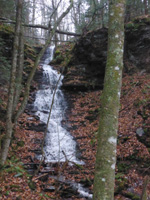
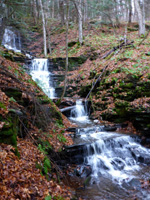
Falls in the Looking Glass Pond outlet stream. 2015 [JAKOB FRANKE]
7.05 Near the bottom of the hillside the trail crosses a stream on a wooden bridge, then heads east to another bridge over Panther Creek.
7.20 From the bridge, turn right and follow along the creek bed downstream to an old logging road that crosses an open field up to Sawyer Hollow Road. If traveling from the opposite direction, one reaches this point just uphill from a DEC fishermen’s parking sign.
7.40 Turn right (east) onto paved Sawyer Hollow Road (CR 20) and follow it into West Fulton. About 200 ft to the left is a small parking area. This road closely follows the route of an old Native American trail that was used during the Revolution by the British in October 1780. On the left the hiker passes the Peter Smith Church, built in 1831 by the founder of West Fulton. At one time it was featured in Ripley’s “Believe It or Not,” because its steeple and bell were located on the hill behind the church. Since then, the church was turned around and the steeple and bell were put in place. It is currently a private residence.
8.60 Reach the Village of West Fulton at an intersection with West Fulton Road. To the right on West Fulton Road and across the stream there is a picnic area on the left side of the road, with room to park several cars. To continue, proceed straight ahead on Patria Road.
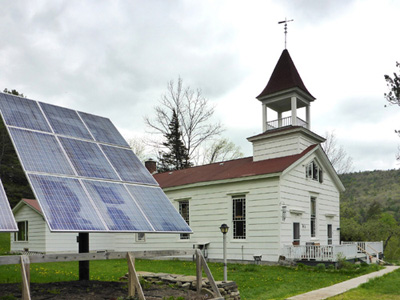
West Fulton. 2014 [JAKOB FRANKE]